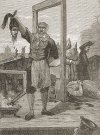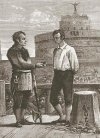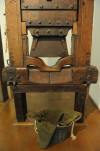vadim69
Governor
Let's remember the most famous executioner of the Roman Pontiffs, or rather the official executioner of the Papal States in 1796-1865 Giovanni Battista Bugatti, nicknamed Mastro Titta (from Maestro di Giustizia - maestro of justice).
In his own way, he was a legendary man. He began his career at 17, and was sent into retirement only at 85. He had 516 executions on his account. He had a special status - he was an outlaw, and was not supposed to leave his home in the Borgo area, except for "official business".
At the same time, it turned out that in any case he had to cross the Ponte Sant'Angelo, and this crossing signaled to the Romans that the execution would take place immediately and it was time to gather for the spectacle at the execution site. The main execution site was in Piazza del Popolo, less often executions took place in 3 other squares of Rome. For his work, Bugatti received a salary of 15 scudo (then in lira) and a bonus for official holidays. Additional payments for the very fact of carrying out an execution were purely symbolic. For example, after the introduction of the lira, the Executioner received only three centesimi for an execution, that is, 3/100 of the Lira, and the Lira was exchanged at a rate of 5.375 lira for 1 scudo.
In general, he was always short of money, so he and his wife sold umbrellas (his father's traditional craft) and souvenirs. Well, his work served as good advertising. Numerous guests of the city came to his house to see the famous executioner and buy a souvenir. This brought him his main income.
After finishing his career, he received a pension twice his salary. He lived on pension for 4 years.
According to the rules of the Papal State of those years, executions were carried out in 3 ways: beheading with an axe, a hammer blow, or hanging. In 1816, the axe execution was replaced by the guillotine. It came from France, but in Rome it was redesigned - the blade was much smaller and it was straight, not beveled, and the condemned's neck was in a special V-shaped collar. And it was the guillotine execution that Roman onlookers loved to watch the most. Bugatti always followed the same ritual. Dressed in a special red suit, he leisurely prepared the place of execution and the guillotine itself. After the condemned was brought to the place, he talked to him for a short time, calmed him down, offered him wine or a smoke as his last wish. Then he laid him on the guillotine and lowered the blade. Near the V-shaped collar of the "death machine" there was a basket, into which the severed head flew. Bugatti took it out of the basket and showed it to the people. The execution was carried out!
In his own way, he was a legendary man. He began his career at 17, and was sent into retirement only at 85. He had 516 executions on his account. He had a special status - he was an outlaw, and was not supposed to leave his home in the Borgo area, except for "official business".
At the same time, it turned out that in any case he had to cross the Ponte Sant'Angelo, and this crossing signaled to the Romans that the execution would take place immediately and it was time to gather for the spectacle at the execution site. The main execution site was in Piazza del Popolo, less often executions took place in 3 other squares of Rome. For his work, Bugatti received a salary of 15 scudo (then in lira) and a bonus for official holidays. Additional payments for the very fact of carrying out an execution were purely symbolic. For example, after the introduction of the lira, the Executioner received only three centesimi for an execution, that is, 3/100 of the Lira, and the Lira was exchanged at a rate of 5.375 lira for 1 scudo.
In general, he was always short of money, so he and his wife sold umbrellas (his father's traditional craft) and souvenirs. Well, his work served as good advertising. Numerous guests of the city came to his house to see the famous executioner and buy a souvenir. This brought him his main income.
After finishing his career, he received a pension twice his salary. He lived on pension for 4 years.
According to the rules of the Papal State of those years, executions were carried out in 3 ways: beheading with an axe, a hammer blow, or hanging. In 1816, the axe execution was replaced by the guillotine. It came from France, but in Rome it was redesigned - the blade was much smaller and it was straight, not beveled, and the condemned's neck was in a special V-shaped collar. And it was the guillotine execution that Roman onlookers loved to watch the most. Bugatti always followed the same ritual. Dressed in a special red suit, he leisurely prepared the place of execution and the guillotine itself. After the condemned was brought to the place, he talked to him for a short time, calmed him down, offered him wine or a smoke as his last wish. Then he laid him on the guillotine and lowered the blade. Near the V-shaped collar of the "death machine" there was a basket, into which the severed head flew. Bugatti took it out of the basket and showed it to the people. The execution was carried out!
















